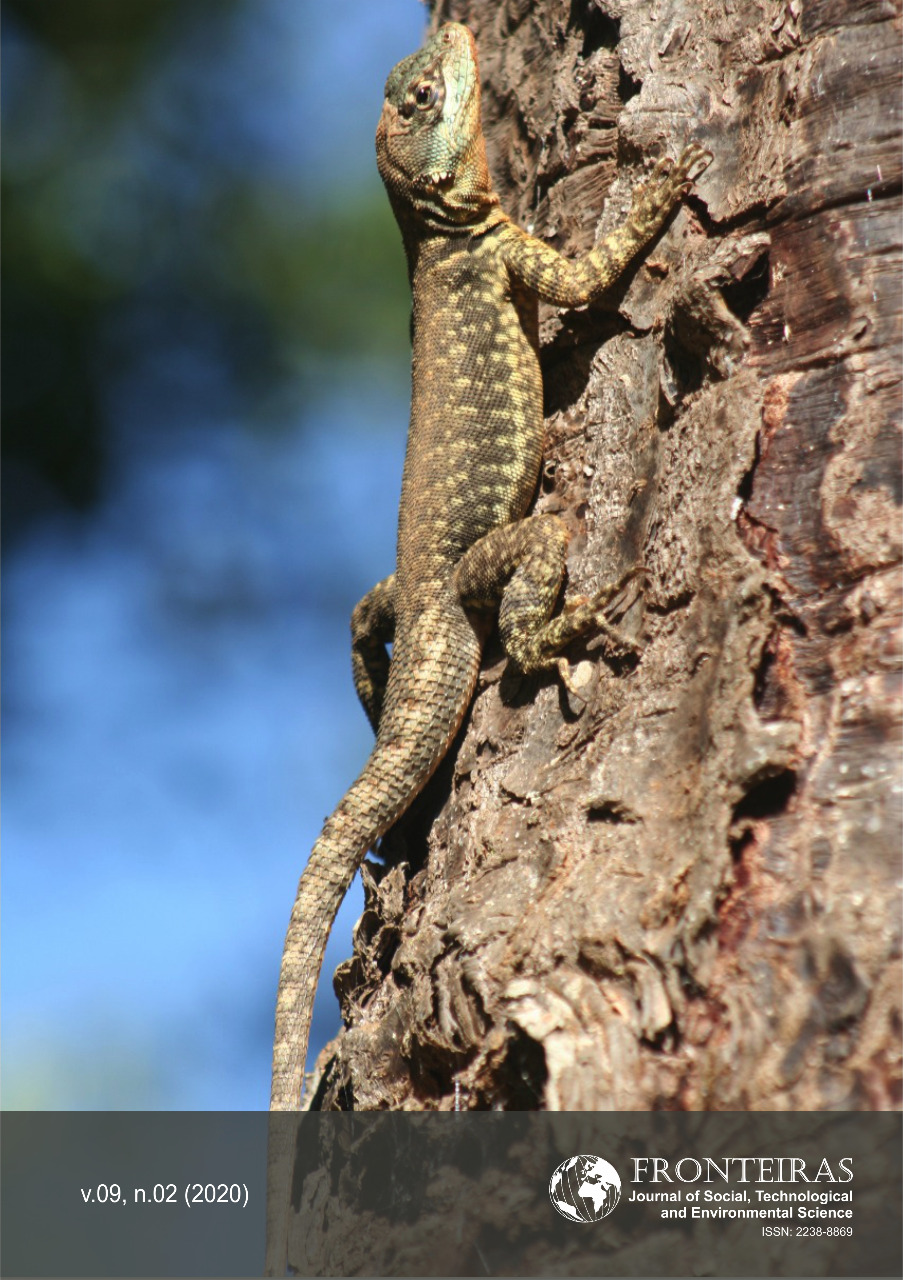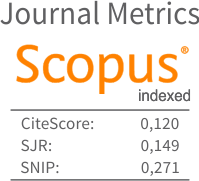Biomonitoring in Limnic Environments: A Scientometric Approach
DOI:
https://doi.org/10.21664/2238-8869.2020v9i2.p53-67Palavras-chave:
monitoramento biológico, IDH, recursos hídricos, bioindicadoresResumo
In the face of increasing human impacts, biomonitoring emerges as an approach to evaluate the status of these ecosystems. Our purpose was to evaluate the publications on biomonitoring in limnic environments and to answer the following questions: (i) What are the approaches in biomonitoring studies around the world? (ii) Are the countries' human development index (HDI) and the available water volume capable to influence publications on biomonitoring? (iii) How are distributed biomonitoring publications by biological groups (e.g., fish, plants, phytoplankton, zooplankton, periphyton, insects) and by environments (lotic and lentic)? To access the publications about biomonitoring in limnic environments, we performed a search in the Web of Science database, restricted between 1991 and 2016. The scientific interest in biomonitoring in limnic environments showed an increasing trend over the years. Furthermore, the countries that presented the highest number of biomonitoring publications had also high HDI values, which reflected high investments in research and development or specific legislation for water quality monitoring. Despite the significant relationship, the water volume was not a major factor influencing the research development. Our study revealed that fish, macroinvertebrates, and lotic environments were the most used for biological monitoring purposes.
Referências
Bonada N, Prat N, Resh VH & Statzner B 2006. Developments in aquatic insect biomonitoring: A Comparative Analysis of Recent Approaches. Annual Review of Entomology, 51(1): 495–523.
Ceballos G, Ehrlich PR, Barnosky AD, Garcia A, Pringle RM & Palmer TM 2015. Accelerated modern human-induced species losses: Entering the sixth mass extinction. Science Advances, 1(5): e1400253–e1400253.
Corlett RT 2015. The Anthropocene concept in ecology and conservation. Trends in Ecology & Evolution, 30(1): 36–41.
Crist E, Mora C & Engelman R 2017. The interaction of human population, food production, and biodiversity protection. Science, 356(6335).
Downing JA, Prairie YT, Cole JJ, Duarte CM, Tranvik LJ, Striegl RG, McDowell WH, Kortelainen P, Caraco NF, Melack JM & Middelburg JJ 2006. The global abundance and size distribution of lakes, ponds, and impoundments. Limnology and Oceanography, 51(5): 2388–2397.
Dziock F, Henle K, Foeckler F, Follner K & Scholz M 2006. Biological Indicator Systems in Floodplains – a Review. International Review of Hydrobiology, 91(4): 271–291.
Easterly W & Levine R 1997. Africa’s Growth Tragedy: Policies and Ethnic Divisions. The Quarterly Journal of Economics, 112(4): 1203–1250.
Flotemersch JE, Stribling J & Paul M 2006. Concepts and Approaches for the Bioassessment of Streams and Rivers. US Environmental Protection Agency, Cincinnati ,Ohio, 245 pp.
Gifford M, Chester M, Hristovski K & Westerhoff P 2018. Human health tradeoffs in wellhead drinking water treatment: Comparing exposure reduction to embedded life cycle risks. Water Research, 128: 246–254.
Isbell F, Gonzalez A, Loreau M, Cowles J, Díaz S, Hector A, Mace GM, Wardle DA, O’Connor MI, Duffy JE, Turnbull LA, Thompson PL & Larigauderie A 2017. Linking the influence and dependence of people on biodiversity across scales. Nature, 546(7656): 65–72.
Karr JR 1981. Assessment of Biotic Integrity Using Fish Communities. Fisheries, 6(6): 21–27.
Khalili NR, Scheff PA & Holsen TM 1995. PAH source fingerprints for coke ovens, diesel and, gasoline engines, highway tunnels, and wood combustion emissions. Atmospheric Environment, 29(4): 533–542.
Krcmar D, Tenodi S, Grba N, Kerkez D, Watson M, Rončević S & Dalmacija B 2018. Preremedial assessment of the municipal landfill pollution impact on soil and shallow groundwater in Subotica, Serbia. Science of The Total Environment, 615: 1341–1354.
Lee S, Jiang X, Manubolu M, Riedl K, Ludsin SA, Martin JF & Lee J 2017. Fresh produce and their soils accumulate cyanotoxins from irrigation water: Implications for public health and food security. Food Research International, 102: 234–245.
Li L, Zheng B & Liu L 2010. Biomonitoring and Bioindicators Used for River Ecosystems: Definitions, Approaches and Trends. Procedia Environmental Sciences, 2: 1510–1524.
Lorenz S, Rasmussen JJ, Süß A, Kalettka T, Golla B, Horney P, Stähler M, Hommel B & Schäfer RB 2017. Specifics and challenges of assessing exposure and effects of pesticides in small water bodies. Hydrobiologia, 793(1): 213–224.
Magurran AE 1988. Diversity indices and species abundance models. In: Ecological Diversity and Its Measurement. Springer Netherlands, Dordrecht, pp. 7–45.
Manoli E & Samara C 1999. Polycyclic aromatic hydrocarbons in natural waters: sources, occurrence and analysis. TrAC Trends in Analytical Chemistry, 18(6): 417–428.
Morina A, Morina F, Djikanović V, Spasić S, Krpo-Ćetković J, Kostić B & Lenhardt M 2016. Common barbel (Barbus barbus) as a bioindicator of surface river sediment pollution with Cu and Zn in three rivers of the Danube River Basin in Serbia. Environmental Science and Pollution Research, 23(7): 6723–6734.
Mylopoulos YA & Kolokytha EG 2008. Integrated water management in shared water resources: The EU Water Framework Directive implementation in Greece. Physics and Chemistry of the Earth, Parts A/B/C, 33(5): 347–353.
OECD 2015. Gross domestic spending on R&D (indicator).
Oertel N & Salánki J 2003. Biomonitoring and Bioindicators in Aquatic Ecosystems. In: Modern Trends in Applied Aquatic Ecology. Springer US, Boston, MA, pp. 219–246.
Payne RJ 2013. Seven reasons why protists make useful bioindicators. Acta Protozoologica, 52(3): 105–113.
Pelicice FM, Azevedo-Santos VM, Vitule JRS, Orsi ML, Lima Junior DP, Magalhães ALB, Pompeu PS, Petrere M & Agostinho AA 2017. Neotropical freshwater fishes imperilled by unsustainable policies. Fish and Fisheries.
Pesce S, Margoum C, Rouard N, Foulquier A & Martin-Laurent F 2013. Freshwater sediment pesticide biodegradation potential as an ecological indicator of microbial recovery following a decrease in chronic pesticide exposure: A case study with the herbicide diuron. Ecological Indicators, 29: 18–25.
Peters NE & Meybeck M 2000. Water Quality Degradation Effects on Freshwater Availability: Impacts of Human Activities. Water International, 25(2): 185–193.
PNUD 2018. http://www.br.undp.org/content/brazil/pt/home/idh0.html. (Accessed 24 January 2018).
Prosi F 1981. Heavy Metals in Aquatic Organisms. In: Metal Pollution in the Aquatic Environment. Springer Berlin Heidelberg, Berlin, Heidelberg, pp. 271–323.
R&D Magazine 2016. R&D Magazine. 2016 GLOBAL R&D FUNDING FORECAST. https://www.iriweb.org/sites/default/files/2016GlobalR&DFundingForecast_2.pdf. (Accessed 23 January 2018).
Reynolds CS 1980. Phytoplankton assemblages and their periodicity in stratifying lake systems. Ecography, 3(3): 141–159.
Steffen W, Richardson K, Rockstrom J, Cornell SE, Fetzer I, Bennett EM, Biggs R, Carpenter SR, de Vries W, de Wit CA, Folke C, Gerten D, Heinke J, Mace GM, Persson LM, Ramanathan V, Reyers B & Sorlin S 2015. Planetary boundaries: Guiding human development on a changing planet. Science, 347(6223): 1259855–1259855.
Tao Y, Yuan Z, Xiaona H & Wei M 2012. Distribution and bioaccumulation of heavy metals in aquatic organisms of different trophic levels and potential health risk assessment from Taihu lake, China. Ecotoxicology and Environmental Safety, 81: 55–64.
van Eck NJ & Waltman L 2010. Software survey: VOSviewer, a computer program for bibliometric mapping. Scientometrics, 84(2): 523–538.
Vaz UL, Cunha HF & Nabout JC 2015. Trends and biases in global scientific literature about ecological niche models. Brazilian Journal of Biology, 75(4 suppl 1): 17–24.
Velez C, Pires A, Sampaio L, Cardoso P, Moreira A, Leandro S, Figueira E, Soares AMVM & Freitas R 2016. The use of Cerastoderma glaucum as a sentinel and bioindicator species: Take-home message. Ecological Indicators, 62: 228–241.
Vieira ACB, Medeiros AMA, Ribeiro LL & Crispim MC 2011. Population dynamics of Moina minuta Hansen (1899), Ceriodaphnia cornuta Sars (1886), and Diaphanosoma spinulosum Herbst (1967) (Crustacea: Branchiopoda) in different nutrients (N and P) concentration ranges. Acta Limnologica Brasiliensia, 23(1): 48–56.
Vinodhini R & Narayanan M 2008. Bioaccumulation of heavy metals in organs of fresh water fish Cyprinus carpio (Common carp). International Journal of Environmental Science & Technology, 5(2): 179–182.
WFD Directive of the European Parliament and of the Council 2000/60/EC., European Union, Luxembourg PE-CONS 3639/1/00 REV 1. § (2000).
Zhelev ZM, Mehterov NH & Popgeorgiev GS 2016. Seasonal changes of basic erythrocyte-metric parameters in Pelophylax ridibundus (Amphibia: Ranidae) from anthropogenically polluted biotopes in Southern Bulgaria and their role as bioindicators. Ecotoxicology and Environmental Safety, 124: 406–417.
Zhou Q, Zhang J, Fu J, Shi J & Jiang G 2008. Biomonitoring: An appealing tool for assessment of metal pollution in the aquatic ecosystem. Analytica Chimica Acta, 606(2): 135–150.
Downloads
Publicado
Como Citar
Edição
Seção
Licença
Esta revista oferece acesso livre imediato ao seu conteúdo, seguindo o princípio de que disponibilizar gratuitamente o conhecimento científico ao público proporciona maior democratização mundial do conhecimento.
A partir da publicação realizada na revista os autores possuem copyright e direitos de publicação de seus artigos sem restrições.
A Revista Fronteiras: Journal of Social, Technological and Environmental Science segue os preceitos legais da licença Creative Commons - Atribuição-NãoComercial 4.0 Internacional.


